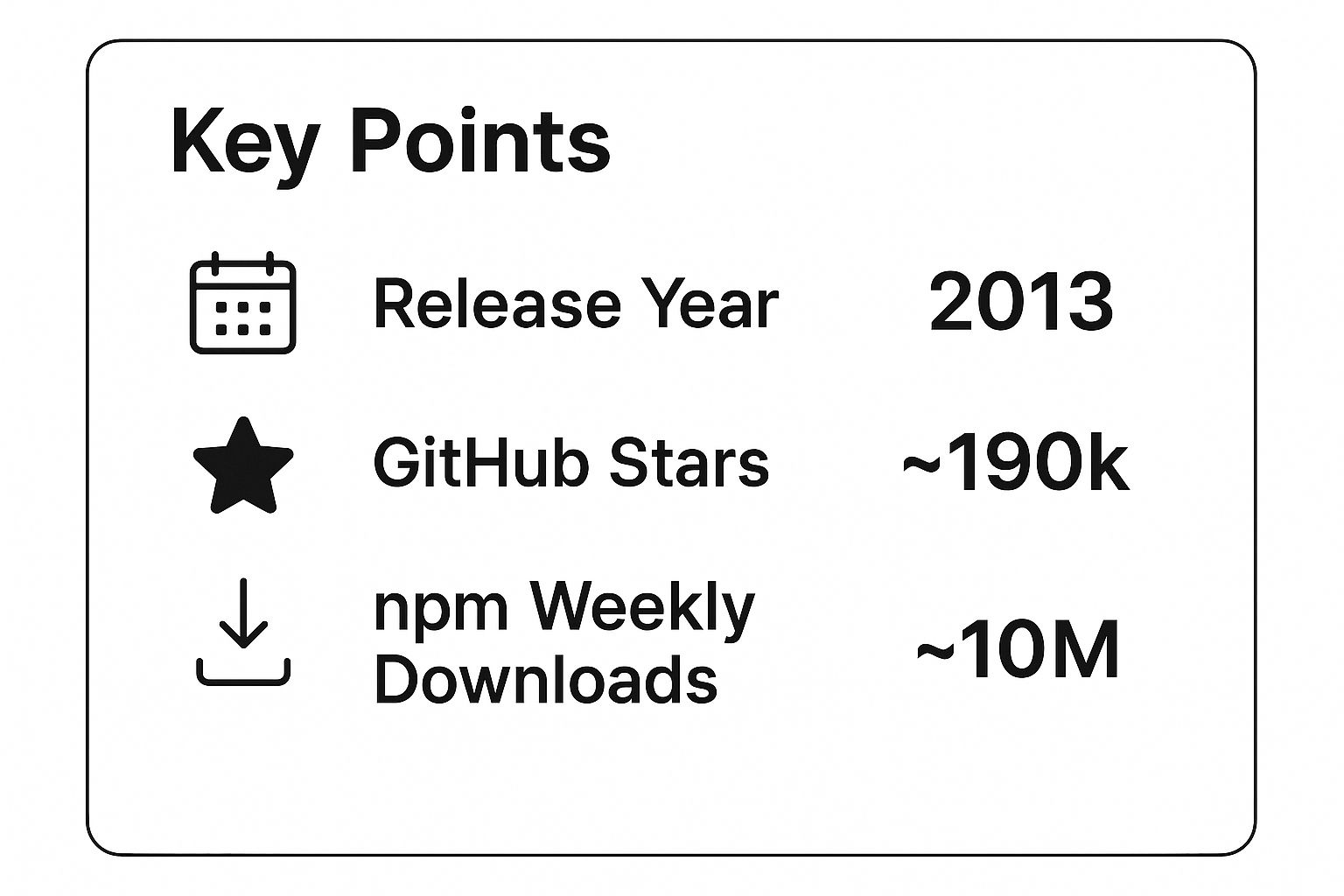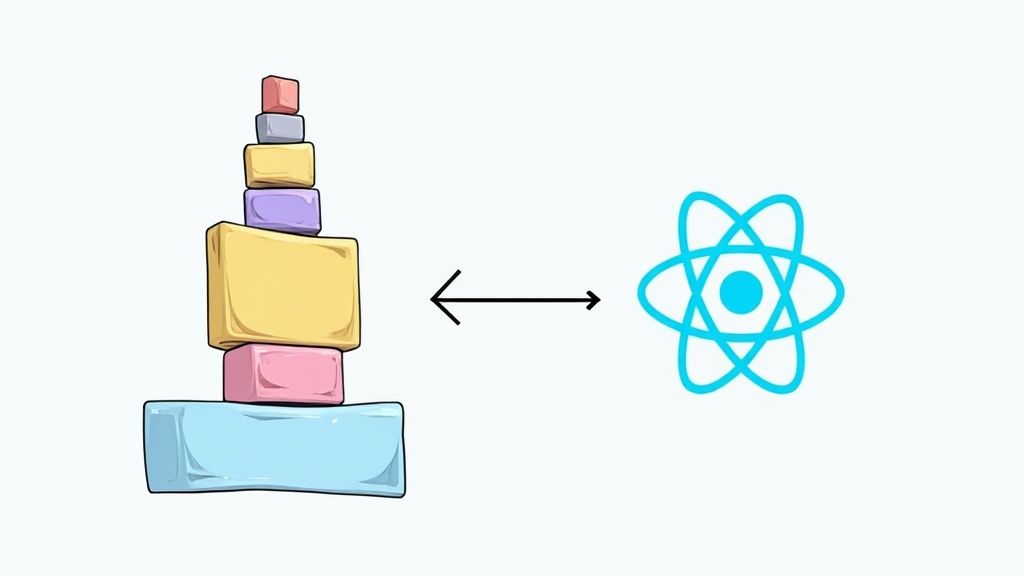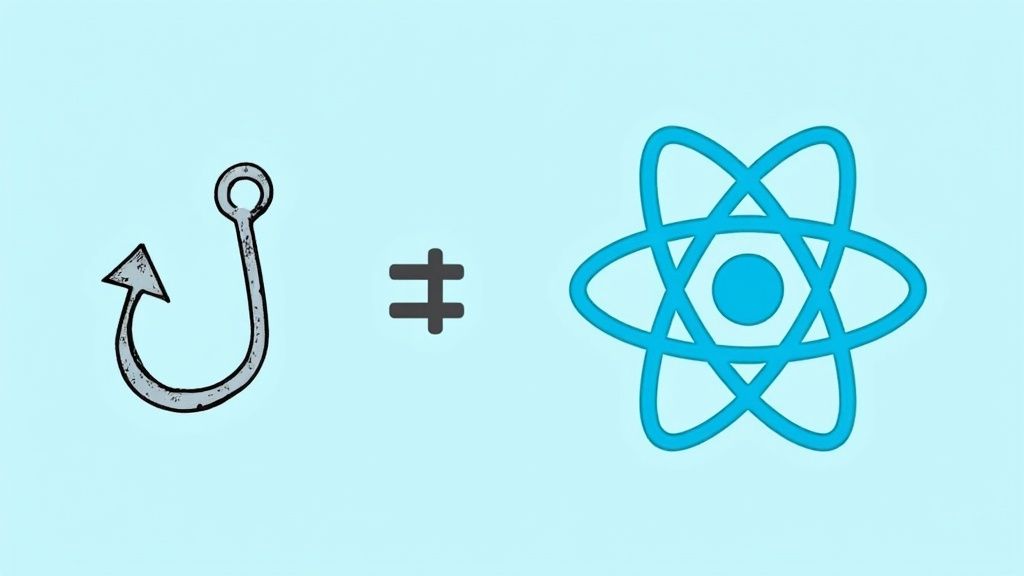Learning React the right way isn't about memorizing syntax. It's about following a smart path: nail down modern JavaScript first, then dive deep into core concepts like components and JSX. Once you've got that, the real learning happens when you start building actual projects. This approach turns what could be an overwhelming task into a clear, manageable journey.
Why Learning React Is a Career-Defining Move
Before you even think about writing a line of code, let's get one thing straight. Learning React isn't just about adding another skill to your resume. It’s a serious investment in your future as a developer.
The biggest names in tech—think Netflix, Airbnb, and Instagram—all use React to build the user interfaces you use every day. That tells you something. It’s built for creating the fast, scalable, and interactive apps that companies and users demand. This massive adoption means the demand for skilled React developers is huge, opening doors to high-impact roles that can shape your entire career.
The Power and Popularity of React
The secret sauce behind React is its component-based architecture. It’s a total game-changer. Instead of wrestling with a giant, tangled codebase, you break down complex UIs into small, self-contained, and reusable chunks of code called components.
Think of it like building with digital Lego bricks. You can snap them together, reuse them, and build almost anything you can imagine. This makes development not just faster, but far more organized and easier to maintain.
This infographic really puts React's explosive growth and lasting popularity into perspective.

The numbers don't lie. React isn't just a fleeting trend; it's a dominant force in web development, supported by a massive and incredibly active community.
A Look at Market Dominance
You can't overstate the framework's influence. By 2025, React is already powering around 11 million websites across the globe, which is a massive slice of the web. Why? Developers have found it can slash development time by an incredible 60% compared to older, monolithic methods. For any business, that's a monumental efficiency boost.
The core advantage is clear: mastering React makes you a more valuable and efficient developer. The skills you gain are directly applicable to building the high-performance applications that companies are actively seeking.
To give you a bird's-eye view, here's a quick breakdown of what your learning journey will look like.
Your React Learning Roadmap Quick Overview
This table outlines the essential stages for getting up to speed with React, moving from the absolute basics to more advanced skills that will make you job-ready.
| Stage | Key Focus | Estimated Time |
|---|---|---|
| Foundations | Mastering modern JavaScript (ES6+), HTML, and CSS | 2-4 Weeks |
| Core React | Components, JSX, Props, State, Hooks (useState, useEffect) | 3-5 Weeks |
| Intermediate Concepts | Routing, State Management (Context API/Redux), API Calls | 4-6 Weeks |
| Building & Deploying | Creating full-stack projects, using build tools, deployment | 4-8 Weeks |
This roadmap provides a structured path, but remember that the real learning happens when you start building.
Once you feel confident in your skills, the next step is showing them off. Using a specialized frontend developer resume template can make a huge difference in how your applications are received. Committing to learning React is your ticket to a more rewarding and future-proof career in tech.
Building Your JavaScript Foundation

Let's get one thing straight: trying to learn React without a decent handle on JavaScript is like trying to build a house on sand. You might get a frame up, but it's going to be a frustrating, wobbly mess that collapses the second you try to add anything complex.
The simple truth is that React is JavaScript. Every single component you build, every piece of state you manage, and every user interaction you handle is just JavaScript, plain and simple.
This isn't about becoming a JavaScript master overnight. It’s about being strategic. We're going to focus on the modern features (often called ES6+) that React relies on day in and day out. Get these under your belt first, and your journey to learn React will be dramatically smoother.
Mastering Modern Variable Declarations
First things first: forget you ever saw var. In modern JavaScript—and by extension, modern React—it’s all about let and const. This isn't just a style preference; it's about writing predictable, less buggy code.
const: Make this your default. You'll use it for almost everything. It creates a constant reference, meaning you can't reassign the variable. This single practice eliminates an entire class of bugs caused by accidentally changing values.let: Save this for the rare occasions when you know a variable needs to be reassigned. Think counters in loops or a value that gets updated based on user input.
Sticking to const forces you to be more intentional about your data flow, a skill that's absolutely critical for managing state in React.
Unlocking the Power of Arrow Functions
You’re going to see arrow functions (=>) everywhere in React code, and for good reason. Yes, they have a shorter syntax, but their real superpower is how they handle the this keyword.
In traditional functions, the meaning of this can change based on where and how the function is called, which has been the source of countless headaches for developers. Arrow functions, on the other hand, don't have their own this; they simply inherit it from their parent. This neatly solves the "binding" problem, making your component logic cleaner and far more predictable.
It means that when you pass an event handler to a button, an arrow function ensures this still refers to your component, just like you'd expect. No more clunky .bind(this) calls in a constructor.
Essential Tools for Data Manipulation
React is all about managing and moving data. Two ES6 features you will use constantly are destructuring and the spread operator. They are powerful shortcuts for working with objects and arrays.
- Destructuring: This lets you cleanly pull values out of objects or arrays into their own variables. In React, you'll use this all the time to extract props. Instead of typing
props.nameandprops.ageover and over, you just write{ name, age }. It’s cleaner and much easier to read. - Spread Operator (
...): This operator lets you expand an iterable (like an array or object) into its individual elements. It's your primary tool for creating copies of arrays or objects, which is fundamental to React's principle of immutability, especially when updating state.
Understanding these data manipulation techniques is non-negotiable. They are not just "nice-to-haves"; they are the idiomatic way to handle props and state in modern React development.
Handling Asynchronous Operations with Ease
Most web apps need to fetch data from an API, and those operations are asynchronous—they don’t happen instantly. This is where Promises and the async/await syntax become your best friends.
A Promise is an object representing the eventual result of an async operation. It’s a huge improvement over the nested "callback hell" of older JavaScript.
Even better is async/await, which is just a cleaner syntax built on top of Promises. It allows you to write asynchronous code that looks and behaves like it's synchronous, making it incredibly easy to follow and debug. You'll be using async/await inside useEffect Hooks all the time to fetch data, manage loading states, and handle errors gracefully. Mastering this will make your data-fetching code look professional and stay maintainable.
Thinking in React Core Concepts

Once you have a decent handle on JavaScript, the real shift begins: you need to start thinking like a React developer. This isn't about memorizing syntax; it's about adopting a whole new mindset for building user interfaces. React's big idea is to break down complex UIs into small, self-contained pieces of code called components.
Think about a typical social media profile. Instead of one giant, tangled HTML file, you'd have a UserProfile component. Inside that, you might find a ProfilePicture component, a UserInfo component, and a PostFeed component. Each one is its own little world, with its own logic and markup, which is what makes React so incredibly scalable.
Functional Components: The Modern Standard
Not too long ago, React developers built everything with class components. You'll definitely still see them in older codebases, but the entire community has moved decisively toward functional components and Hooks.
Why the big change? Functional components are just cleaner, shorter, and way easier to test. They're literally just JavaScript functions that return something that looks like HTML. This evolution has made React much more approachable for newcomers.
If you're starting to learn React today, pour 99% of your effort into understanding functional components and Hooks. Knowing that class components exist is useful for older projects, but you don't need to be an expert in them to succeed.
Here’s a quick look at why the new way is better.
| Feature | Class Component | Functional Component with Hooks |
|---|---|---|
| Declaration | class MyComponent extends React.Component | function MyComponent() { ... } |
| State | this.state = { count: 0 } | const [count, setCount] = useState(0); |
| Lifecycle | componentDidMount(), componentDidUpdate() | useEffect() Hook |
| Readability | More boilerplate, confusing this keyword | Cleaner, more direct, and easier to follow |
The functional approach gets rid of the dreaded this keyword and bulky constructors, leaving you with code that’s much simpler to reason about.
Understanding JSX: The Syntax of React
One of the first things that jumps out in a React component is JSX, which stands for JavaScript XML. It looks almost exactly like HTML, but it's supercharged with the full power of JavaScript.
JSX lets you write your UI declaratively, right inside your JavaScript files. Behind the scenes, tools like Vite or Create React App compile this familiar-looking syntax into plain old JavaScript function calls that create the HTML elements for you.
This means you can drop JavaScript logic directly into your "markup." You can render variables, loop over arrays to create lists, or conditionally show an element based on application logic.
Check out this simple welcome message:
function WelcomeMessage({ user }) {
const greeting = "Hello"
const elementStyle = {
color: "blue",
fontSize: "24px",
fontFamily: "Arial, sans-serif",
}
return (
<div className="welcome-container" style={elementStyle}>
<h1>
{greeting}, {user.name}!
</h1>
{user.isLoggedIn && <p>Welcome back to the dashboard.</p>}
</div>
)
}See how we can use the greeting variable and even render the <p> tag conditionally with a simple && operator? Notice className instead of class and the camelCase style object—these are small but important differences from regular HTML.
Managing Data with Props and State
The two pillars holding up any React application are props and state. Understanding the difference between them is non-negotiable for becoming a proficient React dev.
-
Props (Properties): This is how you pass data from a parent component down to a child. The data flow is strictly one-way (parent to child), and props should be treated as read-only. A child component should never modify the props it receives.
-
State: This is data that a component owns and manages internally. State is meant to change over time, typically based on user interactions. Whenever a component's state changes, React is smart enough to automatically re-render just that component to reflect the update.
Let's use an analogy. In a UserProfile component, the user's name and avatar URL would likely be passed down as props from a higher-level App component. But whether the "Follow" button has been clicked is a piece of state managed entirely within the UserProfile component itself.
Introducing Essential Hooks
Hooks are special functions that let you "hook into" React's core features—like state and lifecycle events—from your functional components. They are the magic that makes functional components so powerful. You'll start with these three.
useState: This is your bread and butter. It lets you add state to a component, returning the current state value and a function to update it.useEffect: This Hook is for handling "side effects"—things like fetching data from an API, setting up timers, or directly manipulating the DOM after a render.useContext: This solves a common problem called "prop drilling," where you have to pass data through many layers of components. Context provides a way to share data globally without all the hassle.
Let's see useState and useEffect work together to fetch and display a list of blog posts.
import React, { useEffect, useState } from "react"
function PostList() {
const [posts, setPosts] = useState([])
const [loading, setLoading] = useState(true)
useEffect(() => {
// This function runs after the component renders
async function fetchPosts() {
try {
const response = await fetch("https://api.example.com/posts")
const data = await response.json()
setPosts(data)
} catch (error) {
console.error("Failed to fetch posts:", error)
} finally {
setLoading(false)
}
}
fetchPosts()
}, []) // The empty array means this runs only once, like componentDidMount
if (loading) {
return <p>Loading posts...</p>
}
return (
<ul>
{posts.map((post) => (
<li key={post.id}>{post.title}</li>
))}
</ul>
)
}Here, useState keeps track of our posts array and the loading status. useEffect handles the API call right after the component first appears on the screen. Mastering these core concepts is the biggest leap you'll take to learn React.
As you get more comfortable, you can start exploring more advanced patterns. A great next step is reading up on React best practices to keep your code clean and scalable.
Ready to move from theory to actual code? You'll need a solid, professional-grade development environment. A clean and efficient setup isn't just a nice-to-have; it's what stops frustrating roadblocks before they start and lets you focus on one thing: learning React. This is how you start writing high-quality code from day one.
First things first, you need Node.js and its package manager, npm. Think of Node.js as the engine that lets you run JavaScript outside of a browser—absolutely essential for modern development tools. Npm is the massive warehouse where you get all your project's "parts," like libraries and other packages. You can grab both together straight from the official Node.js website.
Launching Your First App with Vite
Not long ago, every tutorial pointed you toward Create React App (CRA). While it still works, the go-to choice for kickstarting a new React project today is Vite. Why? It's ridiculously fast. It uses native ES modules to give you a near-instant server start and Hot Module Replacement (HMR), which means your changes pop up in the browser almost immediately without a full page refresh.
Getting started is as simple as running a single command in your terminal:
Just follow the prompts, cd into your new project folder, and run npm install. In a couple of minutes, you'll have a fully functioning React application up and running. That's a massive speed boost compared to the older tools.
Essential Tools for High-Quality Code
With your project set up, it's time to arm your code editor. For React development, Visual Studio Code (VS Code) is the undisputed industry standard, thanks to its powerful features and a huge library of extensions.
A professional setup isn't just about making the code run. It’s about ensuring the code you write is clean, consistent, and easy to maintain. Tools like linters and formatters automate this, instilling professional habits from day one.
Here are the extensions you absolutely need to install in VS Code:
- ESLint: This is your personal code reviewer, working in real-time. It catches potential errors, bugs, and stylistic issues, pushing you to follow best practices automatically.
- Prettier: This is an opinionated code formatter that puts an end to all debates about tabs versus spaces. Every time you save, it automatically reformats your code to a consistent style.
Getting ESLint and Prettier to play nicely together is the hallmark of a professional workflow. It ensures your code isn't just correct, but also perfectly formatted and readable.
Finally, make sure you install the React Developer Tools extension for Chrome or Firefox. This tool is a lifesaver for debugging. It lets you inspect your component hierarchy, see their props and state in real time, and even analyze performance bottlenecks.
Once you're comfortable, a great next step is to start styling your app. You can learn how to install and configure Tailwind CSS in your React project, a modern styling solution that pairs perfectly with a Vite setup.
Turning Theory into Practice with Real Projects

You can binge tutorials and read docs all day, but the real "aha!" moments in React happen when you get your hands dirty and actually build something. Theory gives you the map, but hands-on projects are where the adventure is. This is the part where fuzzy concepts like state management and component composition finally click.
Making that switch from just consuming information to actively creating is what solidifies your skills. It's one thing to watch someone else debug an error; it's another thing entirely to hunt down your own bugs and figure out why your state isn't updating.
Let’s walk through a couple of foundational projects that will cement what you've learned and kickstart your portfolio.
Your First Project: The Classic To-Do List
Just about every developer has built a to-do list app at some point, and there's a good reason for that. It’s the perfect training ground. You get to wrestle with React's core ideas in a practical setting without getting totally overwhelmed.
Don't underestimate this little app. Building it forces you to get comfortable with the essentials:
- Managing State with
useState: You’ll need state to hold the list of tasks, and you'll need another piece of state to track what the user is typing into the input field. - Handling User Events: This means writing functions that fire when a user clicks a button to add a new task or clicks another to delete one.
- Rendering Lists with
.map(): You'll get plenty of practice iterating over your array of tasks to dynamically render each to-do item on the screen. - Passing Props: You'll almost certainly create a
TodoItemcomponent and learn how to pass data (like the task's text) and functions (like ahandleDeletefunction) down to it as props.
The goal isn't to build the next big productivity app. It's to build muscle memory for the patterns you’ll use in every single React project you touch from here on out.
Leveling Up with a Data-Fetching Project
Okay, you’ve conquered the to-do list. Now it's time for something more dynamic: an app that pulls in data from a public API. Think movie search, recipe finder, or a simple weather dashboard. This is where you learn a skill every web developer needs: working with external data.
This kind of project forces you to learn how to handle asynchronous operations, which is just a fancy way of saying "waiting for something to happen." You’ll learn how to manage that entire data lifecycle right inside your React components.
Building an API-driven project is a huge milestone. It’s the moment you go from creating self-contained little widgets to building apps that can interact with the wider web. This is how you build something genuinely useful and interactive.
For this project, you'll need to wrap your head around a few key concepts:
- Fetching Data with
useEffect: This is the go-to Hook for making an API call as soon as your component first loads. - Managing Loading and Error States: In the real world, data doesn't appear instantly. You'll use
useStateto track whether you're still loading or if something went wrong, so you can show the user a loading spinner or an error message. - Conditional Rendering: This is the magic that lets you display different UI based on the current state. You'll show a "Loading..." message while fetching, the movie data once it arrives, or "No results found" if a search comes up empty.
- Component Composition: You’ll start thinking more about breaking down your UI into smaller, reusable pieces—maybe a
SearchBarcomponent, aMovieListcomponent, and aMovieCardcomponent that all work together.
Nailing a project like this shows you've got a solid, intermediate grasp of React. It's a fantastic portfolio piece that tells potential employers you can build applications that are more than just static pages. For more inspiration, check out our guide on other great React projects for beginners.
Navigating the Broader React Ecosystem
Getting comfortable with components, props, and state is a huge win. Seriously, pat yourself on the back. But that's just the foundation. To build a real-world, feature-rich application, you'll need to venture out into the wider React ecosystem.
Core React is brilliant but intentionally lean. It doesn't have an opinion on things like page navigation or managing complex data across your app. That's where the ecosystem shines. You'll need to learn how to pick the right tools for handling routing, managing shared data, and building beautiful user interfaces without reinventing the wheel.
Handling Navigation with React Router
Out of the box, React builds what we call a Single-Page Application (SPA). The entire app loads once, and then JavaScript handles all the "page" changes without a full browser refresh. This makes for a super fast, fluid user experience. But how do you actually create different pages?
The undisputed king of routing is React Router. It's the tool that lets you map your components to specific URLs, making your SPA feel like a traditional multi-page website. You can set up routes for /, /about, or even dynamic ones like /products/:productId and tell React exactly which component to show. It gives you the best of both worlds: familiar URLs and the snappy performance of a SPA.
Managing Complex State
As your apps get bigger, you'll inevitably run into a headache called "prop drilling." It’s that annoying process of passing data down through five, six, or even ten layers of components just because a deeply nested child needs it. It’s messy and a pain to maintain.
While React's built-in Context API can help with this, dedicated state management libraries offer more power and fantastic developer tools for more complex situations.
Think of global state management as a central data hub for your app. Instead of passing data down the component tree, any component can just connect directly to the hub to get what it needs or to update it.
Here are the two heavy hitters you'll see everywhere:
- Redux Toolkit: This is the modern, official way to use Redux. It cuts down on the boilerplate that gave original Redux a bad rap and provides a predictable, centralized store for your app's state. It’s an absolute beast for large, complex applications where data integrity is critical.
- Zustand: A much simpler, more lightweight alternative. It uses a clean, hook-based API that feels very natural to anyone who knows React. People love it for small to medium-sized projects because it's so quick to set up and learn.
Which one should you choose? For a massive app with intricate data flows, Redux Toolkit offers a solid, battle-tested structure. But if you just need a simple global store without all the ceremony, Zustand is an excellent choice.
Building Beautiful UIs Faster
Let's be real: no one wants to build every single button, modal, and dropdown from scratch. That's where UI component libraries come in, saving you hundreds of hours while ensuring your app looks professional and consistent. Libraries like Material-UI (MUI) and Chakra UI provide huge collections of pre-built, accessible components that you can easily customize.
And for that extra bit of magic? Animation libraries. They make it easy to create delightful, performant animations that bring your UI to life without having to fight with complex CSS.
At Magic UI, we're all about empowering developers to build stunning, animated interfaces without the hassle. Our library has over 150 open-source components built with React, Typescript, and Tailwind CSS, letting you drop professional-grade animations and UI elements into your projects in minutes.
Check out our components and templates at https://magicui.design and see just how fast you can elevate your next React app.
